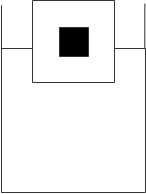
There is a metal cube inside a block of ice which is floating on the surface of water. The ice melts completely and metal falls in the water. Water level in the container:

(A) Rises
(B) Falls
(C) Remains same
(D) Nothing can be concluded

Answer
564.3k+ views
Hint
We know that density is a measure of the mass per volume. The average density of an object equals to the total mass divided by its total volume. An object made from a comparatively dense material, such as the iron, will have less volume than an object of equal mass from some less dense substance, such as water. Based on this concept we have to solve this question.
Complete step by step answer
We know that when ice with piece of metal floats, the volume V of water displaced is given by:
$ V=\dfrac{M+m}{{{\rho }_{w}}} $ .
In the above expression, the M and m are the masses of ice and metal respectively and $ \rho $ is the density of water.
When the ice melts completely then,
Volume of water displaced by metal $ {{V}_{1}}=\dfrac{m}{{{\rho }_{w}}} $
Volume of water due to conversion of ice into water = $ {{V}_{2}}=\dfrac{M}{{{\rho }_{w}}} $
Therefore, we can say that the total volume of water displayed as:
$ {{V}_{total}}={{V}_{1}}+{{V}_{2}} $
So now we have to put the expression in the following form:
$ \dfrac{m}{{{\rho }_{w}}}+\dfrac{M}{{{\rho }_{w}}} $
After evaluating the above expression, we get that:
$ \dfrac{m+M}{\rho -w} $
Now, we can say that $ {{V}_{total}}=V $ .
Therefore, there is no change in the level of water. Hence the correct answer is ‘remains the same’.
So, the correct answer is option (C).
Note
The density gives us an idea how much space an object or substance takes up, in this case the volume, in relation to the amount of the matter in that object or the substance, by which we mean its mass.
Another way to put it is that density is the amount which gives us an idea about the volume that is to be considered per unit of the substance.
If we know that an object is heavy and compact, it has a high density, and if the object is light then the density will always be low.
We know that density is a measure of the mass per volume. The average density of an object equals to the total mass divided by its total volume. An object made from a comparatively dense material, such as the iron, will have less volume than an object of equal mass from some less dense substance, such as water. Based on this concept we have to solve this question.
Complete step by step answer
We know that when ice with piece of metal floats, the volume V of water displaced is given by:
$ V=\dfrac{M+m}{{{\rho }_{w}}} $ .
In the above expression, the M and m are the masses of ice and metal respectively and $ \rho $ is the density of water.
When the ice melts completely then,
Volume of water displaced by metal $ {{V}_{1}}=\dfrac{m}{{{\rho }_{w}}} $
Volume of water due to conversion of ice into water = $ {{V}_{2}}=\dfrac{M}{{{\rho }_{w}}} $
Therefore, we can say that the total volume of water displayed as:
$ {{V}_{total}}={{V}_{1}}+{{V}_{2}} $
So now we have to put the expression in the following form:
$ \dfrac{m}{{{\rho }_{w}}}+\dfrac{M}{{{\rho }_{w}}} $
After evaluating the above expression, we get that:
$ \dfrac{m+M}{\rho -w} $
Now, we can say that $ {{V}_{total}}=V $ .
Therefore, there is no change in the level of water. Hence the correct answer is ‘remains the same’.
So, the correct answer is option (C).
Note
The density gives us an idea how much space an object or substance takes up, in this case the volume, in relation to the amount of the matter in that object or the substance, by which we mean its mass.
Another way to put it is that density is the amount which gives us an idea about the volume that is to be considered per unit of the substance.
If we know that an object is heavy and compact, it has a high density, and if the object is light then the density will always be low.
Recently Updated Pages
Master Class 11 Social Science: Engaging Questions & Answers for Success

Master Class 11 Physics: Engaging Questions & Answers for Success

Master Class 11 Maths: Engaging Questions & Answers for Success

Master Class 11 Economics: Engaging Questions & Answers for Success

Master Class 11 Computer Science: Engaging Questions & Answers for Success

Master Class 11 Chemistry: Engaging Questions & Answers for Success

Trending doubts
What is meant by exothermic and endothermic reactions class 11 chemistry CBSE

Which type of resource is iron ore A Renewable B Biotic class 11 social science CBSE

10 examples of friction in our daily life

Differentiate between an exothermic and an endothermic class 11 chemistry CBSE

Difference Between Prokaryotic Cells and Eukaryotic Cells

1 Quintal is equal to a 110 kg b 10 kg c 100kg d 1000 class 11 physics CBSE




